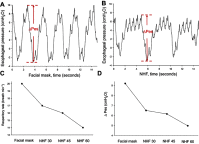Nasal high flow: physiology, efficacy and safety in the acute care setting, a narrative review
- PMID: 31213930
- PMCID: PMC6549413
- DOI: 10.2147/OAEM.S180197
Nasal high flow: physiology, efficacy and safety in the acute care setting, a narrative review
Abstract
Nasal high flow (NHF) is a promising novel oxygen delivery device, whose mechanisms of action offer some beneficial effects over conventional oxygen systems. It is considered to have a number of physiological effects: it improves oxygenation, dynamic lung compliance, homogeneity and end expiratory lung volume; it decreases anatomical dead space and generates a positive airway pressure that can reduce respiratory rate, the work of breathing, and enhance patient comfort. NHF has been used as a prophylactic tool or as a treatment device mostly in patients with acute hypoxemic respiratory failure such as pre-oxygenation before intubation, immunocompromised patients and acute heart failure. Moreover, there is some evidence that NHF could be used during procedural sedation. Finally, NHF was deemed to be effective in chronic obstructive pulmonary disease patients with its positive end expiratory pressure effects and dead-space washout. However, careful monitoring is crucial to maximize NHF settings aimed at maximizing patient comfort while limiting the risk of delayed intubation. The present review presents the most updated evidence for NHF use in the adult acute care setting with the goal of providing clinicians with useful insights on the physiologic effects, main clinical indications, and safety issues of NHF treatment.
Keywords: acute respiratory failure; nasal high flow; oxygenation therapy; physiological effects; positive end-expiratory.
Conflict of interest statement
Dr T Mauri received speaking fees for lectures during symposia by Fisher and Paykel outside the submitted work. The authors report no other conflicts of interest in this work.
Figures


